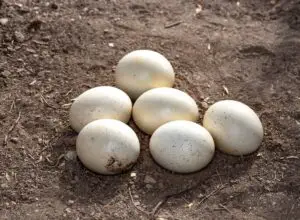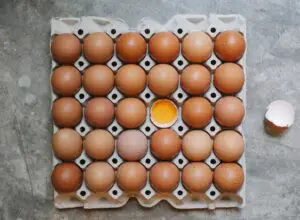Some links on this page may contain affiliate links which means that, if you choose to make a purchase using the link, Agricfy.com may earn a small commission at no extra cost to you. For more information, go to our Affiliate Disclosure Page!
Introduction
Have you ever wondered why there are so many hues of eggs? Are you aware that an egg’s color can convey intriguing details about the bird that laid it and perhaps have cultural significance? Yes, it is correct.
In this informative article, we’ll explore the fascinating world of eggs, their many colors, and the tales they contain.
You might imagine the traditional white or brown eggs from your neighborhood grocery shop when you think of eggs.
However, have you ever seen blue, green, or even spotted eggs? These hues all conceal something that must be revealed.
Continue reading to learn how people from different cultures use colored eggs in their customs.
Let’s go right into the world of colored eggs, then, shall we?
Overview: Colored Eggs: Different Types of Eggs, Why They Are So, and The Meaning
The first picture that frequently comes to mind when we think of colored eggs is that of colorful, exquisitely painted Easter eggs.
But colored eggs serve many other purposes besides just celebrating the festival.
The remarkable range of hues that eggs come in can be attributable to a number of biological and environmental variables.
There is no need for paintbrushes, boiling water, or food coloring for nature to naturally color eggs.
Let’s investigate how this occurs. As the egg develops in the hen’s oviduct, pigments are applied to the shell, giving the egg its many colors.
Between the ovary and the tail on the hen’s backbone lies an organ resembling a tube called the oviduct.
In the hen’s ovaries, an egg, or yolk, develops. As it enters the oviduct, a fully developed ovum leaves the ovary.
There, it goes through a five-stage procedure to help guarantee the yolk gets outside of the egg securely. It often takes somewhat longer than 24 hours for an egg to develop.
The pigments that give the shell its color are applied during the fourth stage of this procedure, which involves the shell gland.
As a result, the color of the shell’s exterior and occasionally its interior varies depending on the breed of chicken.
Types of Colored Eggs
Here, we’ll examine the various colored egg varieties and what makes them special.
1. White Eggs

White eggs are an old-fashioned favorite that we frequently find in our fridge.
How do these eggs become white, though? Well, it all depends on the hens that lay the eggs.
These traditional white eggs are typically laid by chickens with white feathers and earlobes. Because they lack the pigments that give eggshells their color, we get those pure, unadulterated white shells.
Because so many commercial egg-laying birds exhibit these characteristics, white eggs are extremely prevalent.
The reason white eggs are so popular commercially is due to their appealingly neat, uniform appearance.
Interestingly enough, there is a persistent misconception that white eggs are better for you than brown eggs or something more natural.
The egg’s nutritional value is unaffected by the color of the eggshell, in spite of popular belief. Just a visual distinction, really!
2. Brown Eggs

Brown eggs, however, have a cozy, earthy charm. However, why do some chickens lay brown eggs and others white ones? It has more to do with the breed of the chicken than the color of its feathers.
The culprits behind brown eggs are frequently chickens with red feathers and earlobes. Protoporphyrin is a pigment that is the recipe’s hidden ingredient.
These hens add this pigment to the developing eggshell, giving it a wonderful brown tint.
It’s interesting how many people think brown eggs are better for you than white eggs or more natural.
Let’s clarify that this is a misconception, though. Brown and white eggs both have roughly the same amount of nutrients.
When it comes to taste and aesthetics, everything depends on personal preference.
3. Spotty Eggs
Having lovely small spots or speckles all over them, speckled eggs are like a work of art created by nature. These specks, which might be brown, green, or blue in color, give the eggshell a whimsical touch.
The appeal of speckled eggshells is in their individuality. Each egg appears to be telling a unique tale and has a unique pattern from the others.
Variations in the pigment that was deposited on the egg’s shell during its creation are what created these patterns.
Therefore, the next time you see a speckled egg, stop to appreciate the small bursts of color that nature has scattered across its surface.
4. Olive-Green Eggs
Even though olive-green eggs can appear as if they belong in a fairy tale, they are in fact wonderful and real.
Olive Egger chickens, a particular crossbreed, are responsible for producing these distinctive eggs.
Combining the genes in charge of producing brown and blue eggshell pigments results in the alluring shade of olive green. It’s like nature is blending colors to make a new shade, and the effect is incredibly beautiful.
Consider yourself lucky if you ever have the opportunity to see the natural craftsmanship at work in the world of eggs if you happen to come across an olive-green egg.
5. Chocolate-Brown Eggs
The French breed of hens known as Marans is known for producing eggs with a rich, chocolate-brown tint.
These eggs are a fantastic visual delight, and their color distinguishes them from the typical white and brown eggs.
A distinct pigment known as protoporphyrin is the secret of these chocolate-brown shells. The distinctively vibrant eggs of Marans chickens are produced as a result of genes that encourage the deposition of this pigment.
Therefore, you receive more than just a delightful gift when you crack open a Marans egg; you also possess a tiny work of eggshell art in your hands.
6. Spotted or Patterned Eggs
Some eggs have detailed spots or patterns that make them look like small pieces of art. Numerous elements, such as the hen’s food and genetics, may contribute to these patterns.
These speckled or striped eggs are beautiful because of their variety. With its particular configuration of spots or lines, each egg can be a singular work of art.
Some of these designs are very gorgeous, and they serve as a reminder of how inventive nature can be, even with the most minute details.
These types of eggs are common with quail birds.
The Colorful World of Pigments in Eggshells
Pigments give life to the colors of eggshells. Eggshells come in a wide range of colors because of two major pigments: protoporphyrin and biliverdin.
The reddish-brown pigment protoporphyrin is added by hens to the eggshell as it forms, giving brown and chocolate-brown eggs their color.
On the other hand, biliverdin is the pigment that gives eggs their fascinating blue and green shells.
Eggs with this color are produced by chickens who have the proper biliverdin gene expression.
Additionally, oocyanin is a different type of pigment. The oocyanin pigment is typically deposited on the Ameraucana breed’s eggs, penetrating both the interior and outside of the shell and turning them blue.
Eggs of other breeds, like the Araucana, Dongxiang, and Lushi, are blue or green.
An olive egger is produced when a brown-egg-laying hen and a blue-egg-laying rooster are crossed.
The hen secretes a brown pigment, which pierces the egg’s blue shell and turns it into a greenish color. The more brown pigment there is in the egg, the more olive-colored it appears.
The Easter egger, barred rock, Welsummer, and Maran are more breeds of hens that produce colored eggs. The color of the egg is determined by the breed and its genetic makeup.
Why Chickens Lay Different Colored Eggs
Ever wonder why some chickens only produce white eggs while others produce brown, blue, or green ones? Genetics has the final say.
The color of the eggs a chicken lays is significantly influenced by its breed. Specific genes that control the expression of the colors on chicken eggshells are inherited.
While other factors can also affect the color and other properties of the shell, heredity still accounts for the majority of egg color variation. Age, nutrition, environment, and stress level are some of these variables for hens.
But in most cases, the breed of the hen will determine what hue of eggs she will lay. Leghorn chickens, for instance, lay white eggs, while Orpington hens lay brown eggs and Ameraucana hens lay blue eggs.
A hen and rooster from a brown egg-laying and a blue egg-laying breed were crossed to create an Olive Egger, a chicken that lays olive green eggs.
Examining the chicken’s ear lobes can provide some fascinating information; typically, those with white ear lobes lay white eggs.
As a result, you can give credit to the chicken’s genes when you see a white egg or an egg that is blue-green.
It’s important to note here that all eggs taste the same, the only significant distinction between eggs from various breeds is their appearance.
Colored Eggs Across Cultures: Symbolism and Traditions
In this section, we’ll delve into the intriguing world of meanings and cultural significance of colored eggs.
– Easter Eggs: Easter eggs are a well-known emblem of rebirth and regeneration in Western culture. They are not only vibrant; they also convey a lot of significance.
The Easter holiday and the resurrected life it represents are both represented by these eggs.
A beloved custom that unites families is the process of dying and decorating Easter eggs.
It’s an imaginative approach to acknowledging the happiness and hope that Easter brings.
– Chinese Red Eggs: In Chinese tradition, red eggs are more than just eye-catching delights; they’re representations of happiness and luck.
These bright red eggs are frequently presented to loved ones to celebrate births and share blessings.
Red eggs have profound cultural significance and are a method to send congratulations on momentous occasions.
Also, red eggs are a sign of joy and prosperity for any event, whether it’s a new birth or a special occasion.
– Pysanky Eggs: Pysanky eggs are genuinely artistic creations from Ukraine. Not only are they vibrant, but they are also beautifully embellished with symbolic motifs.
On a pysanky egg, each color and pattern has a special meaning.
These eggs aren’t simply for decoration; they’re a form of expression that frequently refers to spiritual, protective, and reproductive themes.
– Cascarones: Cascarones, the hollowed-out eggs loaded with confetti, are more than simply party favors. In Hispanic tradition, they represent joy and fortune.
These eggs are frequently utilized at festivals and celebrations where people crack them over their heads as a sign of good luck.
It’s a happy custom that gives celebrations a playful touch and makes people grin.
Conclusion
You now understand that colored eggs are not just an intriguing scientific phenomenon but also have a rich fabric of cultural and symbolic value.
Colored eggs give a window into the complex interplay between nature, culture, and human tradition thanks to the variety of eggshell colors, the causes behind their colors, and the deep meanings associated with them.
You now have a greater understanding of the vivid world of colored eggs, whether you enjoy breaking open a white, brown, blue, or green egg for breakfast or taking part in festive customs like Easter egg dying.
They reflect the beauty and diversity of the world around us and are more than simply sustenance; they are also representations of life, hope, and joy.
To recap, below are the types of colored eggs you should know in no particular order:
- White eggs
- Brown eggs
- Spotty eggs
- Olive-Green eggs
- Chocolate-Brown eggs
- Spotted-Patterned eggs
So, keep in mind the tales these vibrant shells tell, from genetics to tradition, and take in the magic of it all the next time you come across them.
I hope you found this article helpful. We’d like to know what you think. Do share your thoughts with us in the comment section below.







